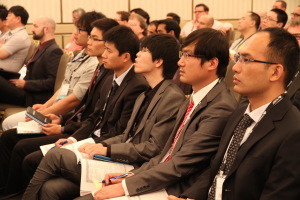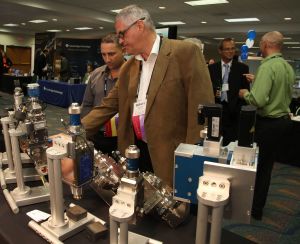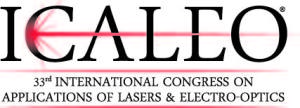By Geoff Giordano
For the first time, presentations at the Laser Institute of America’s 33rd International Congress on Applications of Lasers & Electro-Optics (ICALEO®) will undergo a peer-review process that will bring even more scholarly rigor to the cutting-edge research presented at the conference.
“It’s my second year as general chair, but there have been a few more years of my being a member of the conference chairs,” says returning Congress General Chair Stefan Kaierle of Laser Zentrum Hannover. “The lessons I have learned have grown during that period, and one of my main findings is that we need a good team, composed out of the conference chairs, the advisory committees and the staff from the LIA in order to set up a good conference. Only if we all work closely together with intense information exchange, are we able to find the best solutions for changes to incorporate or just to decide on how successful parts of the conference can be further improved or maintained.”
The most significant improvement for the flagship LIA event, to be held Oct. 19-23 in San Diego, CA, is a brainstorm that arose directly from attendee feedback.
“A big novelty of course is the implementation of peer-reviewed papers in the conference for the first time ever in order to further improve the scientific level of the event,” Kaierle explains. “The idea to introduce peer review of papers arose from the fact that more and more often in recent years I heard from colleagues who did not take their latest research results to ICALEO because they wanted to publish these results first in a peer-reviewed journal. This led me to the idea to introduce that process at ICALEO.” This year, peer review is optional “and all those that ‘survive’ that process will be published in a special edition of the Journal of Laser Applications® (JLA).”
“Since this peer review of papers is a lot of work, we have motivated all the members of the advisory committees to participate in the evaluation of the papers,” he says. “And since these are all experienced researchers, we are able to maintain a very high quality level. The final decision on acceptance of the papers will be by the conference chairs and the general chair in a final step.” Papers will be reviewed “by at least three people each, so that there is always a broad base for reaching the final decision. Typically a reviewer is allocated three to five papers max.”
World-Class Research
 As always, ICALEO offers something for everyone at every career stage.
As always, ICALEO offers something for everyone at every career stage.
“Young career professionals should not miss any parts of the program!” Kaierle urges. “Of course, some topics may not be relevant for everybody, but due to the large number of parallel sessions, there should always be a topic of interest for everybody. And besides the technical sessions, I also highly recommend that attendees participate in the short courses on Sunday, since there will be interesting presentations — especially for newcomers. Last but not least, the social program, which includes the President’s Reception and all the other excellent networking opportunities, should be taken advantage of, since there is always a wonderful forum for getting to know colleagues in the field and starting new collaborations.”
Besides the Sunday short courses, overseen by Kerstin Funck of Ruhr University Bochum (Germany), are the traditional education tracks and business forum and panel discussion.
“We’re excited about the number and quality of papers, which is likely driven by the introduction of the peer-review option,” notes Silke Pflueger of DirectPhotonics, chair of the Laser Materials Processing (LMP) Conference. “Aside from driving higher-quality contributions, it also increases the visibility of ICALEO and the LMP. As is the case every year, the majority of contributions are in the area of welding and additive manufacturing — but plenty of other topics have exciting contributions. As in the previous years, the LMP starts Monday afternoon with a subplenary, this year highlighting the use of lasers in energy generation. While this has traditionally meant cladding of machinery used in energy generation, this year’s subplenary puts a new twist on it: How can we use lasers to decommission power plants?”
Meanwhile, Laser Microprocessing Conference Chair Henrikki Pantsar of Cencorp notes that “areas that have increased the most since last year are laser processing in renewable energy and microelectronics. It will be interesting to see especially the former and the differences in research focus since 2010, when the number of papers in this field sharply declined. I am waiting to see the recent advances in solar cell processing and the impact on efficiency.” This year, “I think that the ability to submit a paper in a peer-review process has attracted more high-quality papers to the conference. So far I have not seen problems in the peer-review process, which is surprising given that this the first year to do it.”
LIA President Yongfeng Lu of the University of Nebraska-Lincoln is once again chair of the Nanomanufacturing Conference. “We have presenters covering different areas of laser nanomaterial applications,” he notes. “These studies present the role of lasers in a variety of advanced applications, including nanoelectronics, photonic crystals, optoelectronics, sensors and plasmonic devices.”
The traditional slate of short courses provides a primer on a variety of fronts. “Talks generally provide a great deal of background knowledge for novices as well as experts of other areas,” Funck says. “The selection of topics reflects what I consider to be of particular interest today and what I, as a researcher, experience to have the greatest impact on the development of laser application technology. There are probably very few participants who are actually experts in all the topics covered in this session. It is the diversity of topics that makes this session interesting.”
Special Features
Always intriguing are ICALEO’s opening and closing plenary sessions; this year’s congress will open with three talks spotlighting ultra high-precision photonic applications and end with a focus on unusual laser applications, including a presentation on the effect of CO2 irradiation on surface and dyeing properties of wool for textile design.
“The plenary sessions have been set up with recommendations from all conference chairs,” Kaierle notes. “In the plenary session, we are always looking to feature a variety of topics ranging from nano to macro, while also having internationally top-ranked presenters able to provide us with new insights in different areas of photonics applications.”
Another highlight of every ICALEO is the presentation of LIA’s Arthur L. Schawlow award, this year being bestowed upon recent LIA Past President Reinhart Poprawe, managing director of the Fraunhofer Institute for Laser Technology (ILT).
“It is a great honor to receive this recognition and be associated so directly with the very best in lasers — the Nobel Prize winner and laser inventor Arthur L. Schawlow,” Poprawe says. “Having been caught up in the fascination of lasers in 1976 while visiting the Shiva laser at Lawrence Livermore, I immediately thought, ‘This is wonderful energy; there must be very many more things we can do with that!’ I committed my professional life to the development and application of lasers in university, in industry and at Fraunhofer.”
Meanwhile, the annual Business Forum & Panel Discussion, led by immediate LIA Past President Klaus Löffler of TRUMPF, Inc., is titled How to Build a Sustainable Business Based on Your Laser Idea and will feature insights from highly successful laser entrepreneurs who have “survived many downturns” in their careers.
These days, Löffler says, “there are more and more new companies starting with short-pulse lasers and ultra-short pulse lasers. But a lot of small companies still start with one laser marking system or a flat-sheet cutting system.” In terms of other opportunities, he says, “there is definitely a way to start with industrial-ready lasers and build special machinery and partner with an OEM laser company. A great opportunity is to start with a laser welding or laser tube-cutting business.”
 Of course, networking remains a key attraction of ICALEO, which offers numerous opportunities to interact with representatives from sponsor companies like IPG Photonics Corporation, SPI Lasers, TRUMPF, Inc., Coherent, JDSU and Spectra-Physics. Attendees can meet key industry players, LIA officials and peers from all sectors of the laser industry at the Sunday Welcome Celebration, Monday evening President’s Reception, the Tuesday night Vendor Reception, LIA’s morning running club and the Annual Meeting & Awards Luncheon on Wednesday.
Of course, networking remains a key attraction of ICALEO, which offers numerous opportunities to interact with representatives from sponsor companies like IPG Photonics Corporation, SPI Lasers, TRUMPF, Inc., Coherent, JDSU and Spectra-Physics. Attendees can meet key industry players, LIA officials and peers from all sectors of the laser industry at the Sunday Welcome Celebration, Monday evening President’s Reception, the Tuesday night Vendor Reception, LIA’s morning running club and the Annual Meeting & Awards Luncheon on Wednesday.
“ICALEO has a lot to offer in terms of networking,” Löffler asserts. “You could start early in the morning by attending the running club. Believe me — at the end of the run you have at least 20 new friends from the laser business.”
ICALEO ultimately represents the efforts of a well-oiled partnership, notes LIA Executive Director Peter Baker: “Team LIA is everybody… all the staff, all the speakers, all the members, all the board people. The trick is we work together to make something happen that we need.”
For more information about ICALEO and to register, visit www.icaleo.org.






